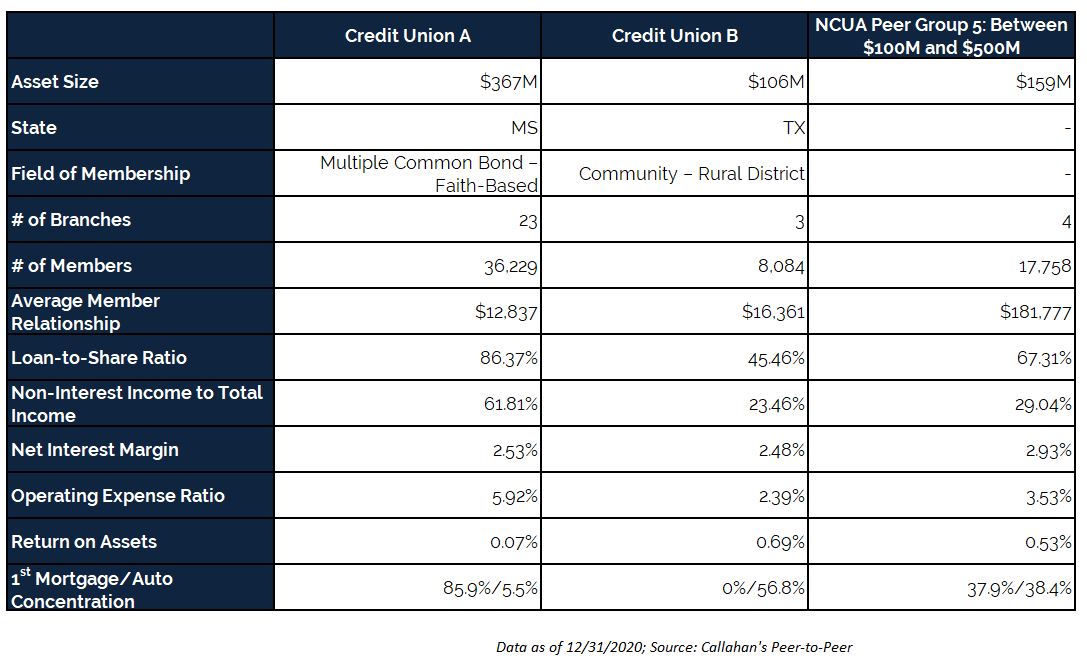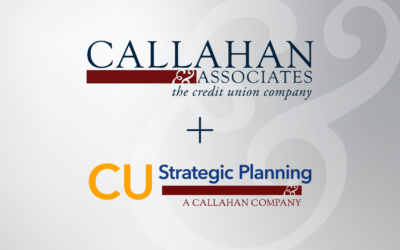While benchmarking your performance against asset-based peer groups has value, relying strictly on asset size for peer group analysis can skew your benchmarks by including credit unions that don’t share much in common with your institution.
Just take a look at this actual example of two credit unions within the same NCUA-designated peer group:

As the table shows, these credit unions are not an ideal comparison for each other even though they are included in and impact the numbers of the same peer group. For more accurate benchmarks against which to measure your credit union’s performance, try using the criteria below in addition to asset size.
Three Peer Group Ideas That Go Beyond Asset Size
Business Model
Credit union financials and operations can differ greatly based on the business model. For instance, non-interest income makes up 61% of credit union A’s total income while it comprises less than 25% of the total income of Credit Union B’s. This not only signifies a difference in how these credit unions generate revenue but also impacts key financial performance ratios like net interest margin and ROA
Loan Concentration
Loan concentration and production show where a credit union’s lending activities are most active and how it generates loan interest income. For example, Credit Union A’s loan composition is made up of 85.9% 1st mortgage loans while Credit Union B does not offer mortgage products and more than 56% of its loans are for new and used autos. Loan mixtures and concentration data help show an institution’s business focus and internal goals, letting you create peer groups of credit unions that are similar to yours in terms of strategy and operations.
Geography
Market dynamics, economic situations, and competition levels differ among geographic regions, states, and even counties. Considering geography is vital as location often impacts members’ demand for financial products, financial capacity, and lives in general. Members in Mississippi may have a different set of wants and needs than those in Texas.
Benchmark Your Credit Union’s Performance
Callahan’s data and analytics tools, Peer-to-Peer and CUAnalyzer, make it easy to build custom peer groups using the data and strategies listed above and more. With hundreds of pre-built formulas, graphs, and tables it’s easy to compare your credit union directly to relevant credit unions and banks.
Callahan clients can log in to the Callahan Portal to access their data and anlalytics tools.
Don’t have access? Click here to request a custom scorecard and we’ll show you how easy it is to build comparisons in Peer-to-Peer.
More Blogs
Callahan & Associates and CU Strategic Planning Combine To Increase Credit Union Impact
Callahan & Associates and CU Strategic Planning proudly announce their strategic alliance, driven by a shared vision to empower credit unions to make a meaningful impact on their members and communities.
Insights And Advice For Credit Union Leaders
Are you new to a leadership role or preparing for one? Are you focused on empowering future leaders? Are you a veteran leader looking to be inspired? We recently asked new and established leaders what it means to embrace different leadership styles, encourage culture changes, and what advice they have for the next generation of leaders.
5 Governance Tips for Credit Union Boards
Insights From Callahan Consultant, Chris Howard There’s a growing — albeit misguided — distrust of credit unions today, making effective governance more important than ever … and harder than ever. At its core, good governance is fairly simple, although never...
15 Key Ratios Every Credit Union Board Should Know
There are thousands of data points you can share with your board about your credit union’s performance, the industry, and the economy. The challenge is identifying which key ratios are most important to your credit union. If you’re looking for a list of key ratios and...
Why Great Lakes CU Is Betting Big On Partnerships
Last week, Callahan & Associates hosted the inaugural installment in its "A Conversation With..." webinar series, featuring Great Lakes Credit Union CEO Steve Bugg. In the exclusive conversation, Bugg emphasized the value partnerships can bring to the industry and...
Browse 5300 Call Reports With Ease.
Every CU 5300 Call Report – Instantly And Seamlessly. If your goal is to reach more credit unions with your products and services, you likely know all too well how long it takes to pull 5300 Call Reports for dozens of prospects to fuel your sales pipeline and...
How Sales Teams Work More Efficiently In Peer Suite
Is your team spending countless hours manually pulling reports and compiling data for your credit union prospects? Are you looking for a more efficient way to collaborate with your team and onboard new members? Callahan’s Peer Suite helps credit union suppliers...
Ultimate Benchmarking Guide For Credit Unions
What Is Benchmarking? Benchmarking is the interpretation and analysis of financial information in order to make direct performance comparisons to other credit unions, banks, and customized peer groups. It enables a credit union to track internal goals, identify...
How Interra Is Advancing Its Purpose Journey
Several years ago, the five-member executive team of Interra Credit Union ($1.7B, Goshen, IN) participated in a virtual learning experience from Callahan & Associates offered in collaboration with Harvard Business School Online.
3 Peer Group Types That Go Beyond Asset Size
While benchmarking your performance against asset-based peer groups has value, relying strictly on asset size for peer group analysis can skew your benchmarks by including credit unions that don’t share much in common with your institution. Just take a look at this...










